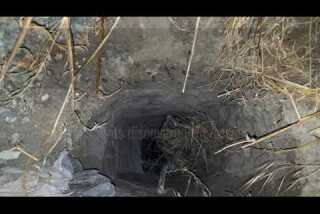New ‘border wall’ may actually be a fence
- Share via
One of President Donald Trump’s main campaign platforms was to build a border wall. Now at the beginning of his second year in office, Congress is locked in a stalemate over funding the wall and providing a pathway to citizenship for so-called “dreamers.”
Meanwhile, the Border Patrol last week touted a new 30-foot structure replacing a little over two miles of decades-old barriers in Calexico as part of “the border wall.” Media announced the development as the first installation of Trump’s wall.
But is it?
Plans for the project began in 2009, according to Border Patrol agent Justin Castrejon, well before Trump as a candidate began calling for a border wall.
Congress has not passed any bills specifically funding Trump’s border wall.
Money for the Calexico project came in Trump’s first year in office with the Department of Homeland Security Appropriations Act, according to a spokesman for Customs and Border Protection. That legislation gives CBP about $260.9 million for “procurement, construction, and improvements.”
The Calexico project contract will cost about $18 million, Castrejon said.
Agents generally used the term “fence” to refer to barriers that were in place prior to the Trump administration. With the announcement of this project, that seems to be changing.
“We are calling this a border wall,” Castrejon said. “It is not a new wall. It’s a replacement wall.”
The new barrier is made of bollards — posts placed close together so that people can’t get through but agents can see if anyone is on the other side. The posts are thicker and taller than the 15- to 20-foot bollards erected in the 2000s in other parts of the El Centro Sector.
The new project is replacing old Vietnam War-era landing mats that were put up in the 1990s.
Ken Walsh, professor of construction engineering at San Diego State University, said the difference between a fence and a wall is that fences can be seen through and have posts.
Walls, he said, are opaque and have a continuous base instead of posts. Height doesn’t make a difference in the terminology, he said.
That would mean the new structure going up in Calexico is a fence, and the landing mat barrier that it’s replacing is actually a wall.
On Thursday, the second day of construction, workers used a large Caterpillar machine to pull down a few pieces of old landing mat.
Mexican authorities patrolled in a shade of trees south of the border to keep anyone from trying to cross through the gap. One paused to record on his phone as workers plucked one of the large metal sheets out of the ground with construction equipment.
Workers hadn’t yet started putting up the new bollards. They lay in a stack nearby.
Pieces of the new structure will go up before more of the old material comes down, Castrejon said, to keep security risks to a minimum.
He said the barrier is not an “end all,” but a “force multiplier.”
It will run from the banks of the New River on the west side of downtown Calexico past Gran Plaza Outlets to a stretch of fields lined with crops, solar panels and, in some cases, just dirt.
The area has been problematic for agents, Castrejon said, both in terms of crossings and assaults on Border Patrol. Agents in El Centro apprehended about 18,500 people illegally crossing the border in fiscal 2017, according to data from CBP.
Known as one of the most polluted rivers in the nation, the New River causes particular trouble, Castrejon said, because smugglers often encourage unauthorized immigrants to use the green, smelly water to swim into the U.S.
Agents are instructed not to go into the water unless there’s a life-or-death emergency. They consider someone trying to splash them with the polluted water as an assault.
Agents hope the updated barrier will prevent people from trying to cross through the river. Castrejon was unable to give details about construction plans for the river itself.
The El Centro Sector of Border Patrol has several types of barriers that vary based on geography and how much action agents see in a particular area.
The western-most part of the sector begins in the mountains, where geography acts as the only deterrent to people crossing into the U.S. without authorization.
Where state Route 98 stretches from Interstate 8 through desert toward the city of Calexico, a low, airy fence lines the border. It doesn’t block people from crossing on foot, but it keeps cars from driving through low brush to the highway, where they can disappear into traffic.
Though “drive throughs,” as agents call them, were a big problem for the area in the past, the sector didn’t have any last year, Castrejon said, and he attributed that to the fencing.
“Infrastructure — it helps. It works,” he said.
The sector doesn’t need to spend resources on more elaborate barriers in that area, he said.
Agents have camera towers to watch for pedestrians in the desert, and they periodically drag old tires to smooth the soil so they can track footprints. Because it can take hours to hike from the border to the highway on foot, Castrejon said, agents have time to catch unauthorized immigrants before they get away.
Closer to Calexico, where the new project is located, agents have less time to catch border crossers before they make it to roads or residential areas. Agents rely on barriers that block pedestrians to help them with their work.
In the 90s, the landing mats were installed along the two-mile stretch leading west out of Calexico where the new structure is now going up.
After the opaque metal sheets were in place, the Calexico Arts Council commissioned a mural along part of the barrier, a friendship bracelet to affirm a close relationship between the two countries that the landing mats separated. A few of the painted sections will be kept in a local museum after they come down.
In the 2000s, a barrier made of bollards went up both in downtown Calexico and between the landing mats and the vehicle fence in the desert.
San Diego also has sections of barrier made of old landing mats. In places that kept agents busy with frequent crossings, the federal government built a second row of fencing.
Because much of the land near the border in Calexico is private property, Castrejon said, secondary fencing was not a viable solution to give agents there more support.
The Calexico construction is one of three projects at the center of a lawsuit challenging the Trump administration’s use of a waiver to comply with environmental laws to speed up border infrastructure work. The waiver was also used on the wall prototypes on Otay Mesa and a planned fencing replacement project in San Diego.
The judge’s decision could come any day, raising questions about what would happen if the Calexico project has to stop.
Castrejon said he couldn’t comment on pending litigation.
A fence isn’t inferior to a wall, said Walsh, the engineering professor. What matters is how well it serves its purpose of keeping people from crossing into the U.S. without authorization.
“By virtue of being taller, whether you call it a ‘fence’ or call it a ‘wall,’ it should still be more difficult to cross,” Walsh said.
Walsh also pointed to the American Society of Civil Engineers report on the condition of U.S. infrastructure. Last year, the country earned a D+ for the quality of its roads, bridges, fences and walls.
“Everything eventually needs to be replaced,” Walsh said.
Regardless of the word used to describe the new barrier, Castrejon is excited about the increased visibility the bollard fence will give to agents working in the area.
“This is historic times,” Castrejon said.
Immigration Videos


When children are separated from their parents at the border, here is where they go next

Prospects of a deal for 'Dreamers' may hinge on separating Trump from hard-liners on his staff

What is DACA?

Border wall prototype contractors selected

Video: Ukrainian boxer wins asylum in U.S.

30 apprehended after Border Patrol agents discover tunnel

Video: Kurdish diaspora prepare to vote on independence
Follow me on Facebook for live updates about immigration news
kate.morrissey@sduniontribune.com, @bgirledukate on Twitter
More to Read
Sign up for Essential California
The most important California stories and recommendations in your inbox every morning.
You may occasionally receive promotional content from the Los Angeles Times.














